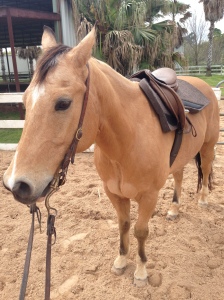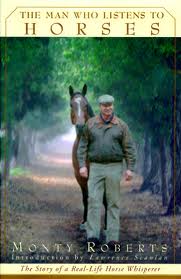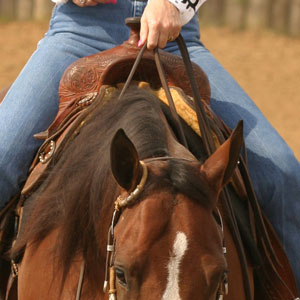Over the last year, Dunnie has been a great teacher, helping me learn all the new tricks I’ve picked up as a Western rider. I thought it was about time that I returned the favor, and last Friday I decided to put an English saddle on him.

I’ve only ridden English twice in the last year, both times on horses that were not Dunnie, and both times I was struck by how much more work it is than Western. There’s so much less saddle to hold you on your horse, and the stirrups are less attached to the saddle, providing much more opportunity for your leg to swing all over the place. So in addition to not knowing how Dunnie would react to the different saddle and style of riding, I really didn’t know how my own body would react to it. I predicted that I’d be pretty sloppy.
Amazingly, that wasn’t the case. First, Dunnie is the best. He reacted so well to the change, even naturally adjusting his stride and movement to my different style of riding (posting at the trot much more, a little more forward center of gravity/arch in the back, etc.). I have to imagine that the significantly reduced weight of the English saddle was like a vacation to him after the serious heft of the Western saddle I ride in, but even so I was so pleased at how quickly he adjusted.
As for me, I was very pleasantly surprised by the strength and stability of my legs. Riding Western, I don’t grip as much with my upper calf as I do in an English saddle — it’s just not possible with the way the stirrups are — but I do use my legs a ton to tell Dunnie where to go and to move him laterally. I’ve also been making a serious point of adding exercise into my rides; I’ve been forcing myself to do a lot of two-point at the trot, posting with no stirrups, and a two-beat posting exercise that means you stand up for two beats, sit for two beats (up-up, down-down), which is a lot more difficult than it sounds. I was able to see the results of all this work in the English saddle, where even at the canter, my leg was rock solid. It just goes to show that constantly going back to the basics in riding is important, no matter what level you’re riding at. I’m constantly reminding myself of fundamentals to work on in my own riding, now that I’m teaching and correcting the kids on these basics over and over.
I think now that I know he’s all right with it, I’m going to add to that exercise regimen one biweekly English ride to provide cross-training to both myself and Dunnie. Now that we’re making some real breakthroughs in our Western riding, including getting him to carry his head much lower than before and finally finally getting some good turnarounds, I’m motivated to keep pushing him, to see what else he can do. While Western is still our main focus, throwing in a little English now and again will be good for both of us just to keep it interesting — a bored Dunnie is a troublemaker Dunnie — and who knows? We might just try out some English classes in addition to the Western ones at our next show.








